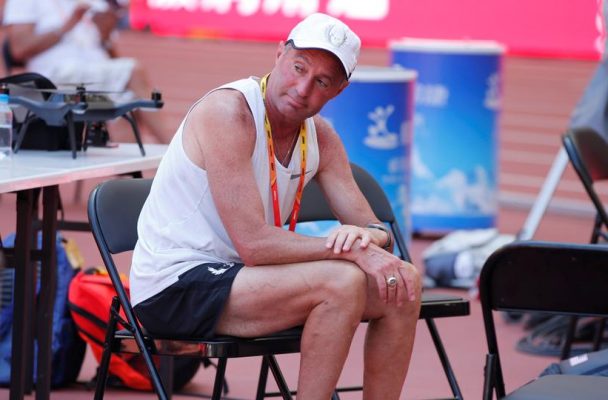Nike once again running into controversy

Nike Oregon Project Coach Alberto Salazar was hit with a four-year ban for his doping scandal. Photo by trtworld.com.
By Tessa Webb
Staff Writer
Nike is more than just a brand. It’s a logo, a swoosh and is considered a sports icon. It has long been associated with athletic excellence, streetwear and some of the most high profile athletes of our time. For decades, Nike’s unprecedented marketing budget, coupled with emotive campaigns featuring the highest caliber athletes in the world, has allowed the company to garner and maintain a cult-like brand status.
Like any many large-scale companies, Nike has experienced its fair share of human rights controversies surrounding the production of their products; however, they have failed to deter Nike’s legion of dedicated followers.
This makes it all the more surprising that the sportswear mammoth has recently shown signs of vulnerability, calling into question their dominance as one of America’s and the rest of the world’s favorite brand. The first anti-Nike movement to garner traction in recent memory was in response to a promotional video featuring controversial former footballer Colin Kaepernick.
It divided American consumers, with some threatening to boycott and posting videos of themselves destroying their Nike products. While the advert did not appear to have long term effects on sales, it showed that the seemingly untouchable brand could take a wrong step in the eyes of some of its consumers.
Like a chink in its armor revealing a plethora of hidden weaknesses, the controversies have kept on coming since then.
Track and field has long been a stronghold of Nike; the 2012 Olympics was a blur of flare pink and yellow on the start line as the vast majority of athletes donned Nike’s distinctive shoes. It seemed like they had successfully hijacked the biggest sporting stage in the world to serve as one giant billboard, especially as their distance runners training under the Nike Oregon Project dominated the competition.
However, the price of this victory was increased skepticism of Alberto Salazar, the head coach at NOP, and his athletes. Investigations by the U.S. anti-doping agency recently culminated in Salazar’s four-year ban from the sport.
Along with the doping incident, Alberto was accused of emotional abuse by teenage distance running phenomenon Mary Cain in a viral New York Times video. Mary told a story of a coach obsessed with winning at all costs, and a fascination with his female athlete’s weight which caused him to place them on restrictive diets despite their extreme training schedule.
Cain further alleged her health was so negatively impacted by Salazar’s training program that she broke several bones and didn’t menstruate for three years. Like other athletes under Alberto’s guidance who have since shared their stories, Mary looks back on her time as a professional Nike athlete as the darkest chapter of her life; cutting herself, starving and being isolated from her friends and family.
After her revelations came to light, Nike was highly criticized for their role in allowing Alberto to become such a powerful and destructive force in the lives of their sponsored athletes.
As a Nike employee, his behavior remained unchecked for years, creating a culture which in any other workplace environment would be seen as abusive and toxic. Their response to the scandal also came under scrutiny. In a press release, they implied that because Cain had shown interest in rejoining the NOP again since the abuse took place, she was not entitled to make allegations against them.
Nike has also faced criticism over the way they handle female athletes who require maternity leave or who plan to have a family. For a brand which capitalizes on promotions based on “girl power” and “dreaming big,” Nike has become notorious for cutting athlete’s pay significantly or ending their contracts altogether if they become pregnant, despite continuing to use them in promotional material and profiting off their image.
Countless women athletes have come forward to expose their treatment and contractual terms, including Olympic marathoner Kara Goucher, who was forced to schedule a half marathon race within three months of giving birth to receive enough money from Nike to support her family.
Recent staff protests at the Portland head office brought up Nike’s poor treatment of Nike employees at all levels of the supply and marketing chain, from sponsored athletes to business people and factory workers.
Although Nike has attempted to silence the dissent, the protest was still widely publicized. This showed the outside world that even from within the seemingly impenetrable Nike bubble there is discontent.
Despite the multitude of controversies, two facts remain. First, Nike has a certain intangible but undeniable “cool factor” and allure to consumers. Secondly, they make quality shoes.
The recent release of the Zoom Vapour Fly 4% and ZoomX Vaporfly Next% has proven this. Independent studies demonstrated 5% faster times for the runners who wear them, a performance advantage which is hard for any top marathoner to ignore.
As Nike comes under fire, they are simultaneously becoming indispensable to professional athletes who will do anything to cut a few seconds off their time. When the choice comes between supporting Nike and their accompanying baggage or wearing a potentially less effective product, athletes have a tough decision to make.
In the shoe technology arms race, Nike is miles ahead of the rest. The question is whether it will be enough to sustain their popularity in the face of an ever-increasing multitude of controversies. The future of Nike is full of uncertainty. Will this empire stay alive or will they run out of steam before this marathon is over?
Only the future will tell.